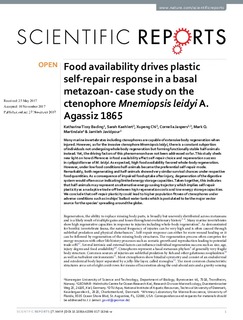| dc.contributor.author | Bading, Katharina | |
| dc.contributor.author | Kaehlert, Sarah | |
| dc.contributor.author | Chi, Xupeng | |
| dc.contributor.author | Jaspers, Cornelia | |
| dc.contributor.author | Martindale, Mark Q. | |
| dc.contributor.author | Javidpour, Jamileh | |
| dc.date.accessioned | 2018-08-24T11:59:26Z | |
| dc.date.available | 2018-08-24T11:59:26Z | |
| dc.date.created | 2018-02-01T20:01:00Z | |
| dc.date.issued | 2017 | |
| dc.identifier.citation | Scientific Reports. 2017, 7 (1), 1-9. | nb_NO |
| dc.identifier.issn | 2045-2322 | |
| dc.identifier.uri | http://hdl.handle.net/11250/2559248 | |
| dc.description.abstract | Many marine invertebrates including ctenophores are capable of extensive body regeneration when injured. However, as for the invasive ctenophore Mnemiopsis leidyi, there is a constant subportion of individuals not undergoing whole body regeneration but forming functionally stable half-animals instead. Yet, the driving factors of this phenomenon have not been addressed so far. This study sheds new light on how differences in food availability affect self-repair choice and regeneration success in cydippid larvae of M. leidyi. As expected, high food availability favored whole-body regeneration. However, under low food conditions half-animals became the preferential self-repair mode. Remarkably, both regenerating and half-animals showed very similar survival chances under respective food quantities. As a consequence of impaired food uptake after injury, degeneration of the digestive system would often occur indicating limited energy storage capacities. Taken together, this indicates that half-animals may represent an alternative energy-saving trajectory which implies self-repair plasticity as an adaptive trade-off between high regeneration costs and low energy storage capacities. We conclude that self-repair plasticity could lead to higher population fitness of ctenophores under adverse conditions such as in ships’ ballast water tanks which is postulated to be the major vector source for the species’ spreading around the globe. | nb_NO |
| dc.language.iso | eng | nb_NO |
| dc.publisher | Nature Publishing Group | nb_NO |
| dc.rights | Navngivelse 4.0 Internasjonal | * |
| dc.rights.uri | http://creativecommons.org/licenses/by/4.0/deed.no | * |
| dc.title | Food availability drives plastic self-repair response in a basal metazoan-case study on the ctenophore Mnemiopsis leidyi A. Agassiz 1865 | nb_NO |
| dc.type | Journal article | nb_NO |
| dc.type | Peer reviewed | nb_NO |
| dc.description.version | publishedVersion | nb_NO |
| dc.source.pagenumber | 1-9 | nb_NO |
| dc.source.volume | 7 | nb_NO |
| dc.source.journal | Scientific Reports | nb_NO |
| dc.source.issue | 1 | nb_NO |
| dc.identifier.doi | 10.1038/s41598-017-16346-w | |
| dc.identifier.cristin | 1561000 | |
| dc.description.localcode | © The Author(s) 2017. Open Access. This article is licensed under a Creative Commons Attribution 4.0 International License. | nb_NO |
| cristin.unitcode | 194,66,10,0 | |
| cristin.unitname | Institutt for biologi | |
| cristin.ispublished | true | |
| cristin.fulltext | original | |
| cristin.qualitycode | 1 | |

